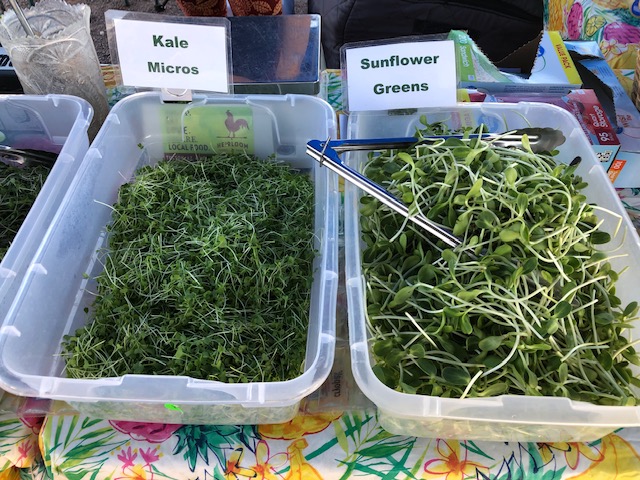You probably know by now that I love my veggies. But you may not know that one of my favorite foods is sprouts. One might even say that I am a little bit obsessed with sprouts because they can always be found somewhere on my plate every time I eat. Now I know some of you are sprout lovers as well, but I think the vast majority of people do not know just how awesome they really are. Well, I am about to change that!
When you hear the word “sprouts,” what comes to mind? Alfalfa sprouts?? That’s usually what most people think of but the world of sprouts goes way beyond alfalfa. Seeds, beans, legumes and even grains are all things that can be sprouted. That’s right…you can actually buy nuts and seeds that look like regular nuts and seeds, add some water and watch the magic begin!
When a plant is allowed to sprout it has a lower glycemic index. The reason this happens is because during the process of sprouting the plant uses a large amount of stored glycogen (sugar) so the end product has a lower glucose content. Why do we like that? Because any time you can eat a food with a low glycemic index, it means the food is digested, absorbed and metabolized slowly. Therefore, your blood glucose level and insulin levels rise at a slow and steady rate so you will not experience any energy surges or crashes.
Another benefit of sprouting is that during this naturally occurring process, the plant retains more protein, healthy fat and minerals. Typically, a week after germination, the sprouts have the highest concentration of available nutrients. In fact, these little guys can have up to 40 times more vitamins and minerals than when they are a mature plant!
Sprouted foods are also much easier to digest. When a nut or seed is harvested before it sprouts, the outer layer remains intact which can be difficult for our digestive system. Conversely, when the seed has sprouted, the shell will crack and be discarded so our digestive system doesn’t have to work so hard.
Another reason sprouts are easier to digest is that they contain an unusually high number of enzymes. Enzymes are an important part of the digestive process because they help to effectively break down food and increase our ability to absorb all the nutrients. A lot of people take digestive enzymes with their meals but why take a pill when you can eat some sprouts and get the same result?
You may have heard about phytic acid and lectins with regards to seeds, nuts and legumes. There has been lots of controversy about these substances because it is believed that they may inhibit the absorption of other nutrients. I’m not completely sold on this idea and I am definitely not willing to give up eating nuts, seeds and legumes because of lectins. Luckily, sprouted foods have a very low content of phytic acid and lectins due to the sprouting process. Sprouting essentially breaks down about 90% of these substances so they will not interfere with the digestive process.
Sprouts are the youngest of the seedling family and the entire plant can be eaten. Because they are so delicate, they are best eaten raw in salads or as a bed or garnish for cooked foods. As you can see from the photos below, there are many varieties to choose from. I think sunflower greens and broccoli sprouts are two of my favorites. You can grow your own sprouts or buy them at the grocery store or farmers market. It’s important to purchase your sprouts from reputable sources and make sure to wash them before you eat them.
I buy my sprouted greens at the farmers market from a local company called Sunflower Supergreens. Their sprouts are grown in a greenhouse with organic, non-gmo seeds, organic soil and no pesticides. I do like to sprout my own mung beans though. I think they are one of the easiest things to sprout. You simply put the beans in a bowl and cover them with water. Be sure to put the water level at least a couple inches above the beans because the beans will absorb the water. Soak the beans overnight to activate the germination and sprouting process. In the morning, drain the beans, rinse well and put them back in the bowl. Keep them on the counter and rinse several times during the day. Within 24 to 48 hours you will see a little white “tail” sprouting from the bean. Trust me it is that easy! After they have started to sprout, you can put them in a clean jar and refrigerate for up to a week.
I am seeing more packaged sprouted nuts, seeds and grains at the grocery store. Some of the brands that I use regularly are Living Intentions, Go Raw and truRoots. You can find them at Sprouts, Natural Grocers or Whole Foods. Some Whole Foods stores sell Living Intentions sprouted walnuts and sunflower seeds in the bulk section. Sprouted nuts and seeds are a bit more expensive but soooo worth it!!
As you can see, sprouts can be an important part of a healthy diet yet they are often overlooked by so many people. Sprouts not only taste delicious, but there are very few foods that can rival their anti-inflammatory, antioxidant and detoxifying qualities.
So, are YOU ready to give them a try? I promise it will be love at first bite!
Enjoy!





